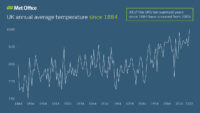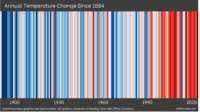Whilst mainland Europe is burning in record breaking heatwaves, here in Cumbria it seems to be the usual summer weather – cloud, rain, some spells of sunshine. It’s the conditions that we would normally expect.
But whilst it may not feel as though the long term climate is changing in our own backyard, unlike overseas, it is clear from the data derived from monitoring of the day to day weather conditions over many years that it is.
The average annual temperature of the UK has increased since 1884 – with 10 of the UK’s hottest years having occurred since 2003.

Source: https://www.metoffice.gov.uk/about-us/press-office/news/weather-and-climate/2022/2022-provisionally-warmest-year-on-record-for-uk
Even closer to home, there is evidence of climate change as average annual temperatures in Cumbria are hotting up – see the ‘climate stripes’ graph below.

Met Office data recorded at the Keswick climate station since 1961 shows that the maximum yearly average temperature has increased from 12.44 degrees in the period 1961-1990 to 13.24 degrees in the 1991-2020 period. The average yearly rainfall total has increased from 1,470.85 mm in 1961-1990 to 1,575 mm in the 1991-2020 period. Air frost days have declined from 68.14 days per year on average in the period 1961 to 1990 to only 44.58 days in 1991-2020.
Evidence of climate change can also be seen in the water temperature of our lakes. A study by the UK Centre for Ecology and Hydrology that focused on four lakes found that four of the five warmest years have occurred since the year 2000.
The heatwaves in Europe may have been described by some of the media as ‘unusual’ but as we continue to pump greenhouse gases into the atmosphere from the burning of fossil fuels, we will experience increasingly extreme, record breaking weather with increasing frequency, hear at home.
Want to know more about weather vs climate and what you can do? Our climate and carbon literacy courses can help.

